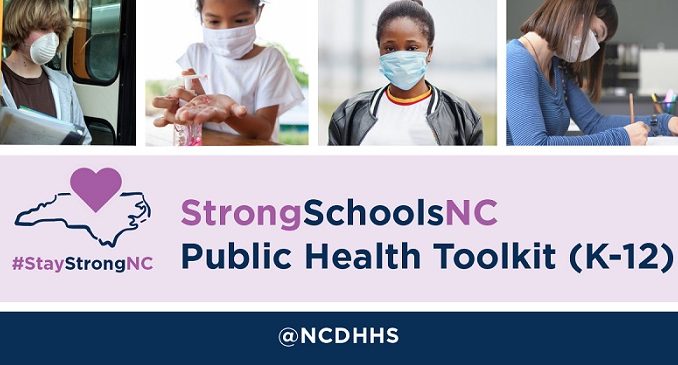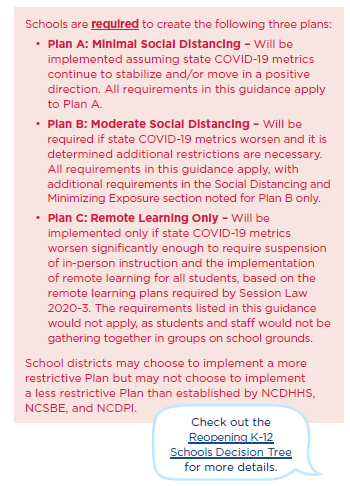
RALEIGH – During a COVID-19 briefing on Tuesday, Gov. Roy Cooper announced the roll-out of guidance for the reopening of the state’s schools potentially set for August.
Cooper was joined by State Board of Education Chair Eric Davis and State Superintendent Mark Johnson for the announcement.
The 26-page document, titled “The Strong Schools NC Public Health Toolkit,” comes with a number of requirements and recommendations including ventilation and water safety, Personal Protective Equipment (PPE) requirements and infection screening and control checklists. The toolkit was put together by the N.C. Department of Health and Human Services (NCDHHS), the N.C. State Board of Education and the N.C. Department of Public Instruction (DPI).
The governor said that “opening schools will depend on our health metrics.” The toolkit states that the determination of what level schools will reopen will be based on the state’s COVID-19 metrics. During the briefing, the governor said the specific metrics will be those taken on July 1.
“We very much want school buildings open. But we won’t be reckless with such an important decision,” said Cooper. He went on to say that “students and staff will be screened for illness before they enter the school.”
The toolkit says that schools will be required to screen all visitors, staff and students. Temperature screening is required for anyone entering a school or boarding school transportation. It is unclear if the bus drivers are going to have to screen the children boarding on the inbound bus to school, but parents can choose to give an attestation that their child was screened by them prior to boarding.
Anyone staff or students that test positive, has come in close contact with someone who is positive or are showing symptoms will be required to stay home. The individuals must remain at home “until they meet the criteria to return.”
“Children will be asked to stay distant from their classmates. They won’t be sharing pencils or textbooks. And there will be a lot of cleaning,” said Cooper.
The toolkit includes two different screening checklists, one for elementary schools and one for both middle and high schools. The questions are basically the same, however, the elementary screener is to be completed by a parent or guardian, whereas the middle and high school screener appears to be designed for the student to complete.
Children are testing positive for COVID-19 but seem to remain mostly asymptomatic. Any symptoms that do present often are mild and similar to the common cold. Children who have become seriously ill and some which have died presented with symptoms similar to Kawasaki disease or Multisystem Inflammatory Syndrome in Children (MIS-C) associated with COVID-19.
Just before the governor’s briefing, the World Health Organization (WHO) announced that the asymptomatic spread of coronavirus is “very rare” and government officials should be mainly concerned with only isolating infected persons with symptoms. By the next morning, WHO official Maria Van Kerkhove “clarified” her previous statement, making the situation more confusing.
Van Kerkhove said the WHO estimates around 16% of people who are asymptomatic and can transmit COVID-19 but that other models suggest that transmission rates of up to 40% might be due to asymptomatic spreaders. She admitted that the “majority of transmission is from people who have symptoms” and are spreading it through infectious droplets.
“But there are a subset of people who don’t develop symptoms. To truly understand how many people don’t have symptoms, we don’t actually have that answer yet,” said Kerkhove.
Comments like Van Kerkhove’s have only added to the confusion about the virus for the public and for those looking to the organizations like the WHO or CDC to inform decision making such as statewide lockdowns and reopening policies for things like schools and businesses.
What’s Required and What’s Recommended
Some of the practices in the toolkit are required, while others are recommendations.
During the briefing’s question and answer session, NCDHHS Secretary Mandy Cohen said that DPI is working to “operationalize” the toolkit. Johnson then said that he wanted to “reemphasize that the health guidance has come from the health experts and it is what schools will continue to follow.”
Chairman Davis remarked that the plan allows for a “variety of situations” including the “most desired” scenario of students back in the classroom with “teachers doing a lot of cleaning.” Davis said that throughout the year it might be possible for schools to have to move “between plans.”
 The plans being referred to are what level the school will operate on depending state and regional metrics on the virus.
The plans being referred to are what level the school will operate on depending state and regional metrics on the virus.
The toolkit includes a “decision tree” for schools to follow prior to opening that takes metrics into account. In that decision tree, districts and schools will be required to create three plans as described in the image to the right.
The toolkit says schools and districts can choose to implement more restrictive plans that those in the decision tree but cannot choose less restrictive ones than those provided by NCDHHS, DPI and the State Board of Education.
Requirements include social distancing measures for seating, hallways, restrooms and entryways. Monitoring of hallways to keep congregating from occurring, discontinuing snack bars or outside meal services are also requirements. Additional requirements include limiting “non-essential visitors” and activities involving outside organizations. There was no elaboration on what constitutes a “non-essential visitor.”
Cleaning and sanitizing requirements must follow specific protocols laid out in the toolkit and cleaning supplies must be from the Environmental Protection Agency’s approved list of “Disinfectants for Use Against SARS-CoV-2 (COVID-19).”
Schools and districts will be required to teach children handwashing techniques, mask hygiene and maintain strict cleaning and sanitizing practices, many of which appear will fall directly on classroom teachers. Schools will be also responsible for “combating misinformation” by disseminating “reliable, age-appropriate and culturally responsible” information from “trusted” resources like the CDC and NCDHHS.
The recommendations included in the toolkit include social distancing to minimize exposure along with frequent reminders to students to stay six feet apart from each other and staff. Desks should also be six feet apart “when feasible” or place barriers between students.
Other recommendations include plexiglass barriers at reception desks, making hallways “one-way,” designate “in’ and “out” doors, and keeping students together in small cohort groups that do not mix with others throughout the day. Meals should be eaten in the classroom to avoid intermixing or even be delivered from the cafeteria for those who rely on a school-supplied lunch.
As with other guidance from the CDC, any and all activities where large groups of children can gather should be canceled. This would be activities like field trips and areas like playgrounds. In addition, schools should hold virtual field trips, parent conferences, assemblies and performances as much as possible.
Student-athletes, those in charge of sporting events, and school teams are instructed to follow the already established rules in NCDHHS’ interim guide for Youth, College and Amateur Sports.
Masks “strongly recommended”
On the minds of most K-12 parents is the question of whether or not their child will be forced to wear a face covering. The answer – at least for now – is no. According to the toolkit, face coverings will be “strongly recommended” but not required. As part of a school’s “infection Control Checklist,” all K-12 schools will have to have at least 5 cloth face coverings on hand both per student and per teacher.
In both March and April, the World Health Organization said that face masks were unnecessary for healthy people. CDC guidance for schools and childcare says that “cloth face coverings are meant to protect other people in case the wearer is unknowingly infected but does not have symptoms.” This CDC statement was echoed by Cohen, however, both Cohen and the governor have made conflicting statements about masks in the past few months.
Cohen said in early April that, “Face masks are really protecting the world from the person wearing the mask, not the other way around.” She also said people should just wash their hands and stay home. She changed her position in May stating in several briefings that the public should be wearing masks.
On May 26, the governor tweeted that a “face covering signifies strength and compassion for others. Wearing one shows that you actually care about other people’s health.” Six days later, on June 1, the governor walked along with protesters with his mask dangling from one ear.
All of the social media images accompanying the toolkit show children wearing a face covering or mask.


